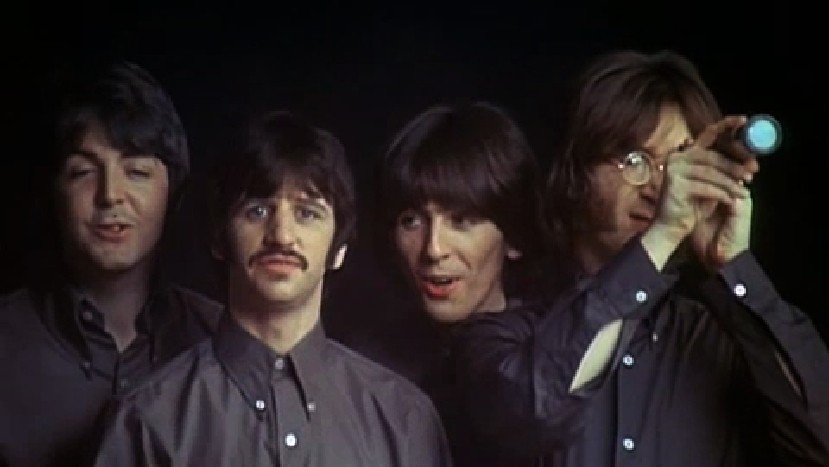
somethingelsereviews.com
The Beatles, “All Together Now” from Yellow Submarine (1969): Deep Beatles
BY KIT O'TOOLE
NOVEMBER 21, 2016
A track written specifically for Yellow Submarine, “All Together Now” could be easily dismissed as a novelty track, a children’s song tailor-made for singalongs. While it may not rank among their most innovative recordings, it demonstrates that the Beatles’ sound represents a bricolage; in other words, the four took existing genres, blended them together, added their unique voices, and created essentially their own category. “All Together Now” obviously mimics children’s songs, but its roots are firmly situated in the British music hall tradition.
Written in the studio, “All Together Now” was primarily composed by Paul McCartney, with John Lennon reportedly contributing the “sail the ship, chop the tree” section. In Barry Miles’ Many Years from Now, McCartney explains that he wanted to write a children’s song based on his own experience.
“I had a few young relatives and I would sing songs for them,” he said. “I used to do a song for kids called ‘Jumping Round the Room,’ very similar to ‘All Together Now’ – and then it would be ‘lying on your backs,’ all the kids would have to lie down, then it would be ‘skipping round the room,’ ‘jumping in the air.’ It’s a play away command song for children. It would be in G, very simple chords. … It’s just a sing along really. A bit of a throwaway.”
The Beatles recorded “All Together Now” during a marathon five-and-a-half hour session on May 12, 1967. With Geoff Emerick substituting for George Martin, the group completed the song in nine takes. First came the backing track, featuring McCartney and George Harrison on acoustic guitars, Lennon on harmonica and guitar, and Ringo Starr on drums and percussion.
Overdubbing followed, with McCartney recording a bass guitar part and his lead vocals. Harrison and Lennon added backing vocals on the chorus; Lennon also added lead vocals on the bridge. More percussion, including the important bass drum, was the last addition. In The Beatles as Musicians: Revolver Through the Anthology, Walter Everett lists even more instrumentation: banjo, plastic saxophone, triangle, and handclaps.
When the Theater Act of 1843 was passed — declaring that licenses would be issued to only establishments run as theaters — the music hall was born. At first, the shows primarily targeted working class audiences, but by 1875 upper classes also found themselves charmed by these unpretentious variety shows. According to writer John Kenrick, all music hall performances involved a “chairman” or emcee introducing singers, dancers and magicians. Venues varied greatly, ranging from formal theaters to converted basements. As Kenrick wrote, only a stage, seats and bar were required for a license.
Music hall performers such as Marie Lloyd, Harry Champion, and George Formby (a George Harrison favorite) would tell jokes and lead adoring audiences in sons featuring simple lyrical structure and repetition. Lyrics often included local references and slang, and could evoke bawdy, romantic, humorous, nostalgic or patriotic images. Note the 1915 song “Pack Up Your Troubles in Your Old Kit Bag,” first performed during World War I and resurrected during World War II. The final section of the tune perfectly encapsulates the singalong aspect of the classic music hall song.
Another 1910 music hall staple is Champion’s “I’m Henery the Eighth I Am,” a humorous singalong later covered by Herman’s Hermits. One can easily visualize ale-filled audiences happily shouting the repetitive chorus.
Paul McCartney grew up in the music hall tradition thanks to his father Jim, a musician who performed in such venues. Playing piano and trumpet, Jim joined the swing band the Masked Melody Makers, which evolved into Jim Mac’s Band. While he mainly performed in music halls during the 1920s, he still played piano at home and would later introduce his eldest son to jazz and musical numbers via his 78 collection. McCartney grew fond of the genre; as a teenager, McCartney tried his hand at writing in the music hall tradition, composing what would ultimately become the Beatles’ “When I’m Sixty-Four.” In 1974, McCartney paid tribute to his father by recording “Walking in the Park with Eloise,” a tune based on Jim’s first composition “Eloise.”
“All Together Now” combines elements of music hall and children’s music. The lyrics contain child-like images, reciting the alphabet and leading young listeners in a sort of dance (“Sail the ship / Chop the tree / Skip the rope”). However, the repetition of the title phrase, the heavily rhythmic elements both spoken and percussive, and the call-and-response motif derive straight from the British music halls. The “bom bom bom” chants that accompany the bridge further imprint the lyrics in the memory, while sounds like the toy saxophone and background whooping create a loose and celebratory atmosphere.
Similar to “I’m Henery the Eighth I Am,” “All Together Now” conjures images of Champion or Formby leading the inebriated audience in a rousing rendition of the chorus. Paul McCartney and the Beatles managed to merge the adult music hall experience with the innocence of childhood, resulting in a fun singalong that perfectly suits the animated Yellow Submarine film.
McCartney explored music hall traditions throughout his Beatles years, penning songs like the aforementioned “Sixty-Four,” “Honey Pie,” and “Maxwell’s Silver Hammer” that all paid homage to a beloved genre and bygone era. Along with these other tracks, “All Together Now” demonstrates how the Beatles could incorporate other genres like Indian, country, Latin, R&B, skiffle, jazz, folk, and music hall, infuse them with their own rock sound, and create their own unique music form.


No hay comentarios:
Publicar un comentario